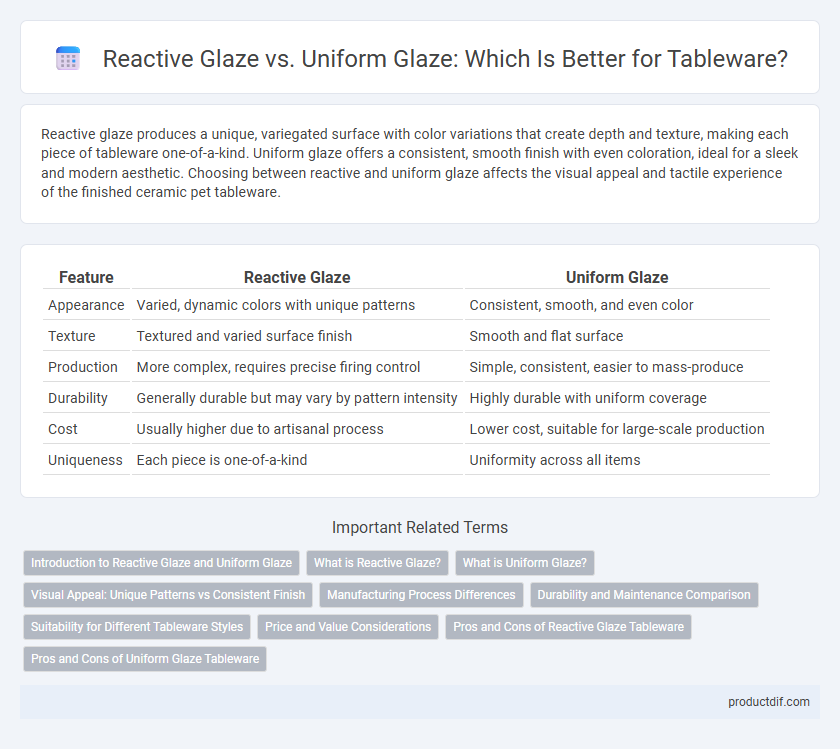Reactive glaze produces a unique, variegated surface with color variations that create depth and texture, making each piece of tableware one-of-a-kind. Uniform glaze offers a consistent, smooth finish with even coloration, ideal for a sleek and modern aesthetic. Choosing between reactive and uniform glaze affects the visual appeal and tactile experience of the finished ceramic pet tableware.
Table of Comparison
| Feature | Reactive Glaze | Uniform Glaze |
|---|---|---|
| Appearance | Varied, dynamic colors with unique patterns | Consistent, smooth, and even color |
| Texture | Textured and varied surface finish | Smooth and flat surface |
| Production | More complex, requires precise firing control | Simple, consistent, easier to mass-produce |
| Durability | Generally durable but may vary by pattern intensity | Highly durable with uniform coverage |
| Cost | Usually higher due to artisanal process | Lower cost, suitable for large-scale production |
| Uniqueness | Each piece is one-of-a-kind | Uniformity across all items |
Introduction to Reactive Glaze and Uniform Glaze
Reactive glaze creates unique, variegated surfaces by interacting chemically with the kiln atmosphere and materials, resulting in unpredictable color variations and textures. Uniform glaze offers a consistent, smooth finish with even color distribution, favored for its reliability and simplicity in design. Both glazes enhance tableware aesthetics, with reactive glaze appealing to artisanal and decorative preferences, while uniform glaze supports mass production and classic styles.
What is Reactive Glaze?
Reactive glaze is a ceramic finish that produces unique, variegated patterns and textures due to chemical reactions during the firing process, creating variations in color and surface effects. This glaze type interacts with the kiln environment, temperature fluctuations, and glaze composition, resulting in unpredictable, artistic designs on tableware. Unlike uniform glaze, which offers consistent smooth surfaces and colors, reactive glaze emphasizes individuality and visual depth on each piece.
What is Uniform Glaze?
Uniform glaze is a consistent and even coating applied to tableware, creating a smooth and glossy surface with minimal variation in color or texture. This type of glaze enhances durability and ensures a predictable aesthetic, making it ideal for everyday use and commercial settings. Unlike reactive glaze, uniform glaze provides a reliable finish that resists chipping and staining over time.
Visual Appeal: Unique Patterns vs Consistent Finish
Reactive glaze creates visually striking tableware with unique, unpredictable patterns that vary from piece to piece, enhancing artistic appeal and individuality. Uniform glaze offers a consistent finish with smooth, even coloration, delivering a sleek and polished look ideal for modern or minimalist settings. The choice between reactive and uniform glaze depends on whether a dynamic, one-of-a-kind aesthetic or a clean, uniform appearance is desired for the tableware collection.
Manufacturing Process Differences
Reactive glaze involves a complex manufacturing process where varying heat levels and mineral reactions during firing create unique, often unpredictable surface patterns, enhancing each piece's individuality. Uniform glaze manufacturing requires precise control of temperature and composition to achieve consistent, smooth finishes with even color distribution across multiple items. These differences impact production costs and batch-to-batch consistency, with reactive glazes typically demanding more skilled craftsmanship and careful firing protocols.
Durability and Maintenance Comparison
Reactive glaze offers a unique, variegated finish that can mask minor imperfections and wear, while uniform glaze provides a consistent, smooth surface that resists chips and scratches more effectively. Reactive glaze often requires gentle hand washing to preserve its intricate patterns, whereas uniform glaze is typically dishwasher-safe and easier to maintain. Durability is generally higher in uniform glaze due to its even application, making it ideal for frequent use and commercial settings.
Suitability for Different Tableware Styles
Reactive glaze creates unique, variegated patterns ideal for artisanal and rustic tableware styles seeking individuality and texture. Uniform glaze provides a smooth, consistent finish suited for modern, minimalist tableware designs emphasizing clean lines and simplicity. Choosing between reactive and uniform glaze depends on the desired aesthetic and the specific use of the tableware piece.
Price and Value Considerations
Reactive glaze tableware typically commands a higher price due to its unique, handcrafted appearance and the complexity of the firing process, offering distinct value for collectors and enthusiasts seeking artistic pieces. Uniform glaze tableware is generally more affordable and ideal for everyday use, providing consistent quality at a lower cost suitable for bulk purchases and commercial settings. Evaluating price against value depends on whether aesthetic uniqueness or practical durability is prioritized in the tableware selection.
Pros and Cons of Reactive Glaze Tableware
Reactive glaze tableware offers unique, variegated finishes with rich textures and color depth that make each piece visually distinctive and artisanal. The main advantages include the ability to hide minor scratches and wear due to its mottled patterns and its appeal to customers seeking handmade or non-uniform aesthetics. However, reactive glazes can sometimes result in uneven surface coatings, potential color unpredictability, and may require more skilled firing techniques compared to uniform glazes that provide consistent, smooth, and predictable finishes.
Pros and Cons of Uniform Glaze Tableware
Uniform glaze tableware offers a consistent, smooth finish that enhances durability and improves resistance to chipping and staining, making it ideal for everyday use. The even surface simplifies cleaning and reduces the chance of harboring bacteria, promoting better hygiene compared to reactive glaze alternatives. However, uniform glaze lacks the unique visual texture and color variation of reactive glaze, which may result in less distinctive or artistic appeal for collectors and designers.
Reactive Glaze vs Uniform Glaze Infographic

 productdif.com
productdif.com